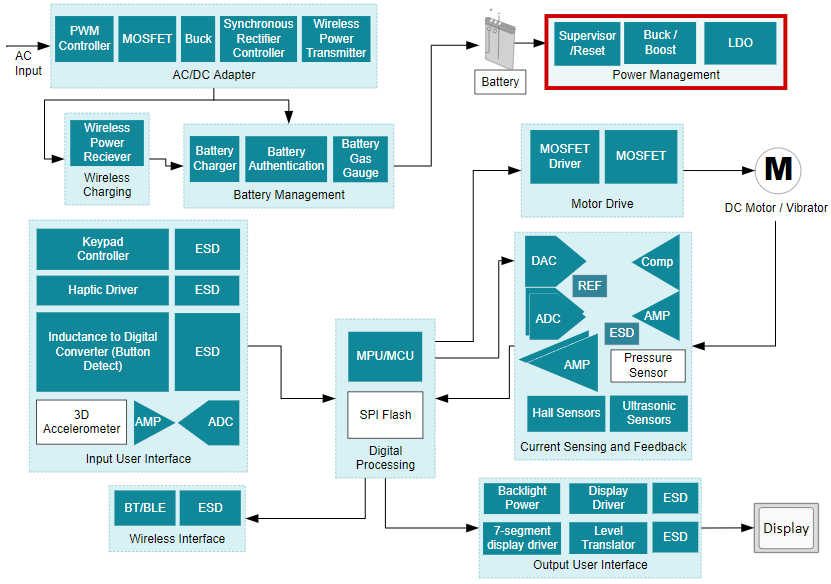SSZT406 september 2019 LM809 , TLV803E , TLV809 , TLV809E , TPS3836
As electronics become more portable, the need for high-accuracy integrated circuits with a small footprint and low quiescent current (IQ) increases. To monitor key voltage rails in handheld electronics such as electric toothbrushes and personal shavers, design engineers typically choose a simple voltage supervisor and look for devices that enable a small solution size and low IQ to improve battery life. However, in the past, optimizing a system often involved a trade-off between space, low IQ and accuracy.
The generic electric toothbrush diagram shown in Figure 1 highlights the internal complexity of a simple handheld product and how the subsystems connect together in such a compact device. Similarly, personal shavers share subsystems that call for the same design needs including low IQ, high-accuracy, and compact size.
 Figure 1 Electric toothbrush block
diagram
Figure 1 Electric toothbrush block
diagramBenefits of low IQ and small size for battery operated devices
In personal electronics such as electric toothbrushes and personal shavers, devices with low IQ could save hours of total battery life. In addition, accurate sensing of the voltage ensures battery is used to its full capacity. Since battery-operated devices are often hand held, this puts space constraints on the electronic components.
A simple voltage supervisor to monitor a single voltage such as a battery needs only three pins – sensed voltage, ground and output, which indicates if the sensed voltage is above or below a chosen threshold. Such simple voltage supervisors are often offered in industry-common three pin small outline transistor (SOT)-23 packages. One example is the TPS3836 - a voltage supervisor (reset IC) with a low IQ of 220 nA available in a SOT-23 package.
However, at 2.9 mm x 1.5 mm, the size of a typical SOT-23 package is often too big for a small battery-operated device. A possible solution is to use an even smaller package such as the extra small outline no-lead (X2SON) package, which measures only 1.0 mm by 1.0 mm and is a quarter of the size of the three-pin SOT-23 package. Engineers looking for a package that’s easy to mount and inspect might prefer one with visible pins, such as a three-pin SC-70 package that measures 2.0 mm by 1.25 mm and is a third smaller than the three-pin SOT-23 package.
The TLV809E comes in a SC-70 package, which allows engineers to considerably shrink the size of their solution when compared with similar devices such as LM809 or TLV809. This small, yet easy to mount package with visible pins can serve a wide breadth of handheld electronics applications.
Another important characteristic for device startup: VPOR
The power-on-reset voltage (VPOR) represents the minimum input voltage (VDD) required for a controlled output state. To maximize the battery capacity and still have reliable device operation, the VPOR voltage should be as low as possible. The TLV803E and TLV809E can achieve a VPOR of 700 mV, which minimizes the range of undefined output and ensures operation to the maximum possible battery capacity.
As engineers design personal devices that are more compact but require more features and increased performance, it is important to think about ways to improve battery life, obtain low IQ and maintain high-accuracy voltage supervision. The TLV803E and TLV809E voltage supervisors provide flexible and powerful monitoring solutions for compact battery-powered devices such as electric toothbrushes and personal shavers.
Additional resources
- Learn more about TI’s portfolio of supervisors in the “Voltage Supervisors (Reset ICs) Quick Reference Guide.”
- See all of the voltage supervisors TI offers.
- Watch the “Voltage Supervisors 101” training series.
- Read this two-part series in TI’s E2E™ support forums: